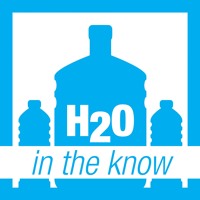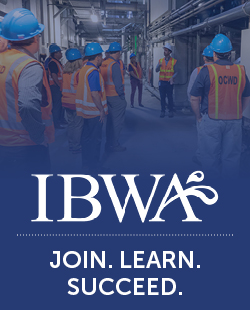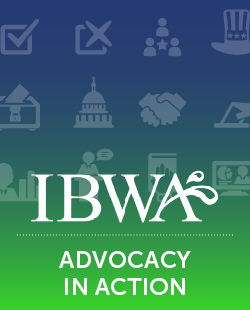June 26, 2002
Mr. Paul J. Tierney
Director
Food Protection Program
Division of Food and Drugs
Department of Public Health
305 South Street
Jamaica Plain, MA 02130-3597
RE: Comments on Proposed Regulations of Bottled Water and Carbonated
Non-alcoholic Beverages (105 CMR 570.000)
Dear Mr. Tierney:
The International Bottled Water Association (IBWA) sincerely welcomes the opportunity to provide comments on the proposed changes to 105 CMR 570.000, the manufacture, collection, and bottling of water and carbonated non-alcoholic beverages proposed regulations.
IBWA is the trade association representing the bottled water industry. Founded in 1958, IBWA member companies account for more than 80 percent of all bottled water sales in the U.S. The association membership includes domestic and international bottlers, distributors, and suppliers, including the following Massachusetts bottlers: Belmont Springs Water Company, Berkshire Springs, Blue Hills Spring Water, Micropack Corporation, Nature Springs and Vineyard Bottled Waters
IBWA supports the Department of Public Health’s (DPH) efforts to harmonize the Commonwealth of Massachusetts’ bottled water regulations with the United States Food and Drug Administration’s (FDA) regulations of bottled water. The incorporation by reference of FDA regulations will assist in compliance with and understanding of DPH’s regulations.
However, there are a few remaining issues within the proposed regulations of concern to the bottled water industry. Below are these concerns and IBWA’s suggestions to improve them. IBWA respectfully offers these suggestions to ensure the regulations will be able to address potential future issues without extensive revisions.
105 CMR 570.003: Definitions
Discussion: IBWA is very concerned with the proposed definition of “minimal treatment.” The proposed definition is far too prescriptive on the use of specific technologies and methods to meet current and new water quality standards. As more research and new regulatory standards on drinking water are developed, the bottled water industry will need flexibility in meeting the compliance challenges. Flexibility to meet the regulatory standards for naturally occurring elements and disinfection by-products is in the best interest of public health and also the goal of the bottled water industry. An example of such a potential need is arsenic. If arsenic can be reduced or removed through a process that selectively targets the element through a process, such as a targeted ion exchange, without changing the basic chemical composition of the water, it serves the public health to promote such innovations without requiring a new regulation. In addition, reducing or eliminating the precursors to disinfection by-products created by one of the three treatments listed in the definition should be permitted within this definition, so long as it does not significantly alter the basic composition of the water. An example of such a method is the addition of carbon dioxide to water. At the time of ozonation, a very small amount of carbon dioxide is added, thus very slightly lowering the pH. FDA recently issued a statement that the use of carbon dioxide to adjust pH, added to bottled water during the ozonation process would be considered a processing aid and does not need to be declared when used to limit bromate formation. A copy of FDA’s letter is enclosed.
As the United States Environmental Protection Agency (EPA) begins another cycle of review of potential contaminants for regulatory standards, it is impossible to predict the various technologies and methodologies for meeting these new standards that will be developed. FDA policy and the IBWA Model Code recognize the potential need to selectively remove or reduce naturally occurring regulated elements without changing the standard of identity. In fact, FDA’s comments in the November 13, 1995 Federal Register stated that “in some instances, the water can be treated to selectively remove these undesirable elements” and “the agency finds that the IBWA Model Code and state requirements are basically consistent with FDA’s informal policy on ‘natural’ because the product is only minimally processed.”
The definition of “minimal treatment” also conflicts with the Codex Standard For Natural Mineral Waters. The U.S. government, through FDA, supports this Standard. It is imperative that there is no significant adverse impact by the Massachusetts’ regulations on commerce both interstate and internationally with no technical basis. The Codex Standard for Natural Mineral Waters precludes treatment other than those allowed to reduce unstable constituents such as arsenic, iron or manganese and does not modify the water’s essential constituents, which give the water its properties. A copy of this Standard is enclosed.
Bottled water products imported into the U.S., which meet the Codex Natural Mineral Waters Standard and have reduced unstable constituents, will face a significant conflict with the proposed regulations that will preclude them from properly labeling their product. In today’s global economy, it is inappropriate and unnecessary for a state to impose unfair trade barriers, particularly when the federal government’s position is contrary to the state.
In 2000, IBWA developed the following performance standard regarding the removal of undesirable elements from bottled water:
A process to remove any undesirable element must be selective and not alter the water significantly. As long as such processing is selective and otherwise complies with FDA’s stated policies on use of the term ‘natural’, such processing shall not preclude labeling the product as ‘natural’. Also the same minimal treatment of spring, mineral, artesian, or well water to selectively remove or reduce the concentration of naturally occurring undesirable elements shall not preclude labeling the product ‘spring water’, ‘mineral water’, ‘artesian water’, or ‘well water’, as appropriate, as long as all other requirements of the applicable standard of identity are met. If the process alters the water significantly that fact must be reflected in the Statement of Identity and the product can not be labeled ‘natural’.
As currently drafted, the proposed regulations would not allow a bottled water company to selectively reduce a regulated natural element to the standard of quality with a process other than one of the listed three and still maintain the standard of identity. This does not appear to serve the best interests of public health. It will discourage companies from providing a safer, purer product by prohibiting them from labeling their product with the appropriate standard of identity while using minimal treatment to selectively reduce or remove particular regulated elements.
Suggestion: IBWA respectfully requests that DPH reconsider the definition of “minimal treatment” to provide bottlers with more flexibility to use processes that selectively reduce or remove naturally occurring regulated elements to meet the standards of quality. As indicated by the enclosed letter from FDA, advice can be sought and received from FDA on particular technology or methodology and its application to the standard of identity. If the particular technology or methodology significantly alters the chemical composition of the bottled water, the application of the standard of identity must also change. If it does not, the product could be determined to be misbranded. Under proposed 105 CMR 570.007, bottlers must obtain approval from DPH for use of new or substantially modified water source. Therefore, IBWA offers the following language to replace the current definition of minimal treatment in 105 CMR 570.003:
“Minimal treatment” means treatment limited to the use of filters (paper, activated carbon, and/or particulate); ozonation; ultraviolet light; and other processes that selectively reduce or remove a naturally occurring, undesirable regulated element, or pre-cursor to disinfection by-product to directly assure compliance of the product with the quality standard in 105 CMR 570.008(A).”
105 CMR 570.007: Water Source Protection, Treatment and Modification for Bottled Water and Carbonated Non-Alcoholic Beverages
Discussion: The use of a new or substantially modified source water under (A)(7) of this section will require prior approval from DPH before a bottled water company could utilize the source water. The draft regulations, however, do not prescribe a time frame for review by DPH. In order to manage bottled water operations effectively, a maximum period for review by DPH should be included. Without such a requirement, planning and management of bottled water production can be negatively impacted.
Under the proposed regulations, source water will be subject to the Massachusetts Department of Environmental Protection (DEP) contaminant parameters, which do not necessarily apply to bottled water. Currently, bottled water Under Section 410 of the Federal Food Drug and Cosmetic Act, FDA must determine, within 180 days of the implementation of an EPA National Primary Drinking Water Regulation (NDWR), the standard’s applicability to bottled water. If FDA takes no action, then the EPA standards will apply to bottled water.
Therefore, the public health is protected no less stringently under the FDA bottled water standards of quality than under the EPA’s national drinking water standards. Bottlers are required to submit the monitoring test results to DPH annually under 150 CMR 570.009 (d). As a result, DPH appears to appropriately have jurisdiction over the compliance with the water quality standards. Therefore, IBWA recommends that DPH develop a source test monitoring waiver program in order to reduce the paperwork and costs associated with testing for elements that are not present and unlikely to be present in source water. Such a program would allow DPH to grant waivers for source monitoring tests to bottlers that can demonstrate “no detections” or “within allowable limits” of the established quality standards for three consecutive years. This program would only affect bottled water sources. The program will principally benefit bottlers within Massachusetts until other states recognize such waivers. California recently initiated such a system with the support of the bottled water industry. Enclosed for your consideration is a copy of the California waiver program.
Suggestion: IBWA suggests the following language be added to (A)(7) after the first sentence.
“The Department shall complete their review of new or substantially modified sources within 60 days of receipt of a completed requested.”
IBWA is willing to work with DPH in designing a source monitoring test waiver program to reduce the paperwork burdens and costs of testing without any potential adverse impact on public health.
105 CMR 570.009: Sampling and Testing Requirements
Discussion and Suggestion: Under (C)(1)(a) of this section, a bottled water plant will have to cease operations when they receive any test results indicating the source product water has exceeded any maximum contaminant level listed in 310 CMR 22.00 or by the EPA. This strict standard does not recognize the potential for testing errors and false positive determinations that are the result of errors by the laboratory or sampling. The water should be retested when an exceedance notice is received to confirm the results. If the non-compliance is confirmed in subsequent tests, then the provisions of 570.009(C)(2)(a)-(d) should apply. This issue was addressed in (C)(1)(b) and (C)(2), and should be incorporated for source water for in-state plants.
In addition, IBWA strong suggests the inclusion of a waiver program as mentioned above.
105 CMR 570.012: Labeling Requirements
Discussion: Under (C)(2) of this section, bottled water must include the source on the label. Presently, all packaged foods, including bottled water, have extensive labeling requirements, including the statement of identity, compliance with the definitions in the Standard of Identity, ingredient labeling, name and place of business of the manufacturer, packer or distributor, and nutrition labeling, if so required. Any other information FDA may wish to require by regulation must be considered a material fact. Specifically regarding source labeling, FDA concluded in the preamble to the Standard of Identity Final Rule that this information was not a material fact and, therefore, not required to appear on a bottled water label (60 Fed. Reg. 57076, 57096).
“…The intent of the proposal was not to require source labeling of all water ingredients from a municipal source, but to require it in the former type of situation, where the finished product is bottled water or the labeling makes an explicit or implied claim concerning the water ingredient.
Under section 403(a) of the Federal Food, Drug, and Cosmetic Act (the act) (21 U.S.C. 343(a)), a product is misbranded if its labeling is false or misleading in any particular. To determine whether the absence of information on food labels constitutes misbranding the agency must take into account the extent to which the labeling fails to reveal facts material in light of representations made or suggested with respect to consequences that may result from the use of the article under customary or usual conditions of use (section 201(n) of the act (21 U.S.C. 321(n))). The agency does not deem source labeling of ingredient water from a municipal source as a material fact unless labeling representations are made or suggested that the water possesses particular properties.”
In addition, FDA regulations prescribe the prominence of required information and their proportional relationships. Under 21 CFR 101.1, 21 CFR 101.105(h), and 21 CFR 101.15, the detail of food product labeling is prescribed in detail. IBWA respectfully suggests that these requirements provide the consumers with the necessary information to make informed decisions. In addition, the proposed information does not provide material fact not currently required. IBWA recommends that this section be deleted from regulation since it has been addressed and rejected by FDA.
Under (C)(3), DPH has included a requirement for a permit number in the current draft of the regulations. With the enactment of HR 3448, the Public Health Security and Bioterrorism Response Act, all bottled water facilities must be registered with FDA. The President signed the legislation into law on June 12, 2002. Under the provisions of the Act, FDA is required issue a registration number for all food facilities that manufacture, process, pack or hold food for human consumption. The law provides for expedited rule making on the registration process, but is self-executing if regulations are not promulgated by December 11, 2003. The Act also encourages cooperation between the FDA and state regulators for inspections and enforcement of the provisions. If DPH insists that bottled water labels include a permit number, the federal registration number should be used for compliance with this regulation. Although the federal government does not intend to require the number on food labels, it would be significantly easier to manage one federal number than a number of various state numbers.
Implementation of a change in bottled water labels must also include an ability to deplete current inventories of labels. Labels for bottled water containers are generally ordered in bulk and the inventory is depleted over time. If a company invests in one year’s supply of labels, they need to be allowed to continue to use the inventory until it is depleted. This practice is commonly referred to as a “sell through” provision. Thus, they can avoid having to discard a substantial number of labels and investment. Therefore, the use of the federal registration number will allow sufficient time to managed a label redesign and order new inventory. Regardless of which permit number is used, IBWA urges DPH to permit bottlers to deplete their current inventories of labels and require any new labels ordered after the effective date to contain the new labeling requirements.
Suggestion: IBWA urges the provisions for source labeling and permit numbers for bottled water labels be deleted in the regulations for reasons stated above. If a permit number is required, IBWA requests the use of the federal food facility registration number and inclusion of a “sell through” provision for current label inventories.
105 CMR 570.013: Supplemental Regulations for Processing and Bottling of Bottled Water and Carbonated Non-Alcoholic Beverages
Discussion: IBWA has recently addressed the use of equipment for multiple purposes in the IBWA Model Code. Under (C) of this section, DHP permits the use of multi-purpose equipment, except for food and beverages that contain fat or protein. Like DPH, IBWA considered restricting multi-purpose to beverages that do not contain fat or protein. However, it became difficult to determine the scope of the change with a restriction on products containing protein. With the number of new products and ingredients on the market, the impact of such a restriction may exclude products for which there is no evidence of an adverse public health affect with using the same equipment for bottling water so long as it is properly sanitized. The Model Code now permits the use of multi-purpose equipment for the production of bottled water so long as the equipment is not used for milk, other dairy products, and non-beverage foods. The bottler is also required to use proper sanitation procedures and have established adequate policy and procedures.
IBWA has also begun requiring bottlers to develop and implement a Hazard Assessment and Critical Control Point (HACCP) plan within their operations. These plans must also include provisions for a risk assessment, monitoring, critical limits, appropriate corrective actions, and records for multi-use equipment. Since DPH does not currently require nor is it proposing bottlers to have a HACCP plan, IBWA has only included the HACCP reference in the suggestion below because IBWA members are currently required to meet this standard if they choose to use equipment for multiple purposes.
Suggestion: IBWA suggests the following provision as a substitute for the current language in the draft regulations in 105 CMR 570.013 (C).
“Water intended for bottling shall not be stored, processed, or bottled through equipment or lines used for milk, other dairy products, and non-beverage foods. Non-dedicated beverage equipment and lines used for other beverages shall be sanitized using a hot clean-in-place (CIP) process, or equivalent. The process must be addressed in the plant’s sanitization standard operating procedure (SSOP) manual and HACCP plan, and shall include provisions for monitoring, critical limits, appropriate corrective action, and records.”
Conclusion
IBWA again thanks the Department for the opportunity to participate in the development of bottled water regulations and to comment on the most recent draft. We look forward to working with the Department in finalizing the draft proposed regulations.
If IBWA can be of assistance to you, or if you need more information, please do not hesitate to contact us.
Sincerely,
Patrick Donoho
Vice President of Government Relations
Enclosure (3)


